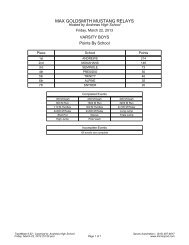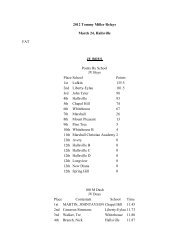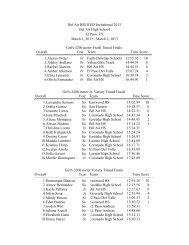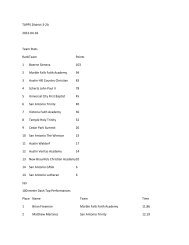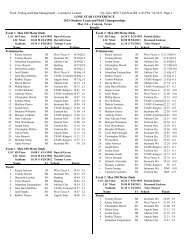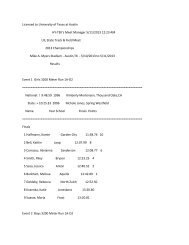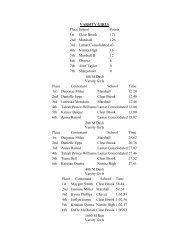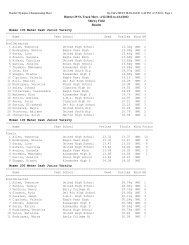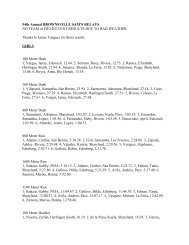1. PAGES 1-35 - Texas Track & Field Coaches Association
1. PAGES 1-35 - Texas Track & Field Coaches Association
1. PAGES 1-35 - Texas Track & Field Coaches Association
Create successful ePaper yourself
Turn your PDF publications into a flip-book with our unique Google optimized e-Paper software.
Peak velocity was noted for each athlete, each trial, and the<br />
compilation of these peak velocities graphed. See Graphs 1 & 2 .<br />
It is important to note that before the data of any trial was<br />
used it was screened for any obvious error. The primary error,<br />
albeit one that rarely occurred, happened during the pole carry<br />
trials. The athlete would drop the pole and prematurely trip the<br />
photo gate. That determination was made on observing the<br />
trail itself and any obvious peak/drop in velocity on the data<br />
sheet. Occasionally a passerby would accidentally bump a tripod<br />
that the photo gate rested upon and trigger a false trip. All<br />
of those trials were eliminated from the data set.<br />
DISCUSSION<br />
The cumulative average velocities, within each segment of<br />
the trial runs, is displayed in Table 1 for both boys and girls<br />
groups, with and without pole carry. Review of Table 1 (which<br />
visually supported in Graph 1) shows that both groups accelerate<br />
rapidly to 90% of their top speed whether carrying a pole or<br />
not. The average of all groups showed an excess of 90% of top<br />
speed within Segment 3. This third five meter segment measurement<br />
accounted for the time taken to run between 13 and<br />
18 meters, or for familiarity, between roughly 42’ and 59’. All<br />
athletes (with the exception of one girl’s trial without carrying a<br />
pole) were still accelerating at this point and, therefore, the<br />
actual 90% of top speed mark likely occurred somewhere<br />
between 50-55’. For the jumper, whether it be long, triple, or<br />
pole vault, that would translate to roughly a 10 step approach<br />
(e.g. 5 lefts). On average, it took the athletes three more segments,<br />
15 meters (about 50’), to accelerate the remaining 10%<br />
to top speed. That path did not necessarily follow a smooth<br />
pattern either as evidenced by , for example, the girls’ runs with<br />
the pole.<br />
The length of run needed to bring these athletes to top speed<br />
is presented in Table 2 and corresponding Graph 2. When running<br />
without a pole, 67% of the boys and 78% of the girls were<br />
at their top speed in this test by the 6th segment or likely somewhere<br />
around 100’. While carrying a pole, 60% of the boys<br />
showed their peak speed by the 6th segment whereas 88% of<br />
the girls were their fastest by this point. This may have been<br />
due to pole length and weight or the skill carrying a pole.<br />
Everyone ran slower when they carried a pole (which only<br />
makes sense) and within these two groups, on average, the<br />
“cost to top speed” of carrying the pole was 4.6% and 5.7% for<br />
girls and boys respectively. Notably, the girls ran faster carrying<br />
AUGUST 2011 techniques 11



